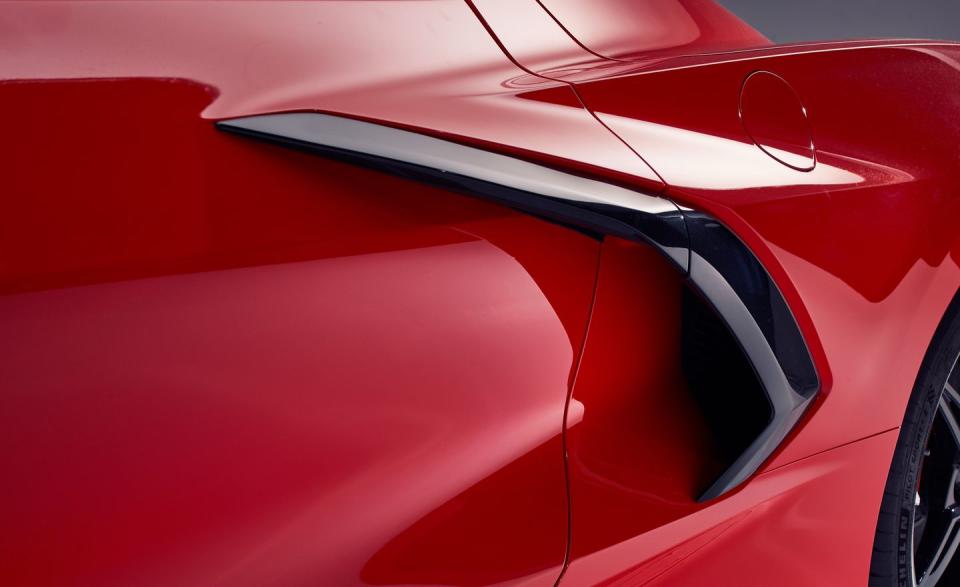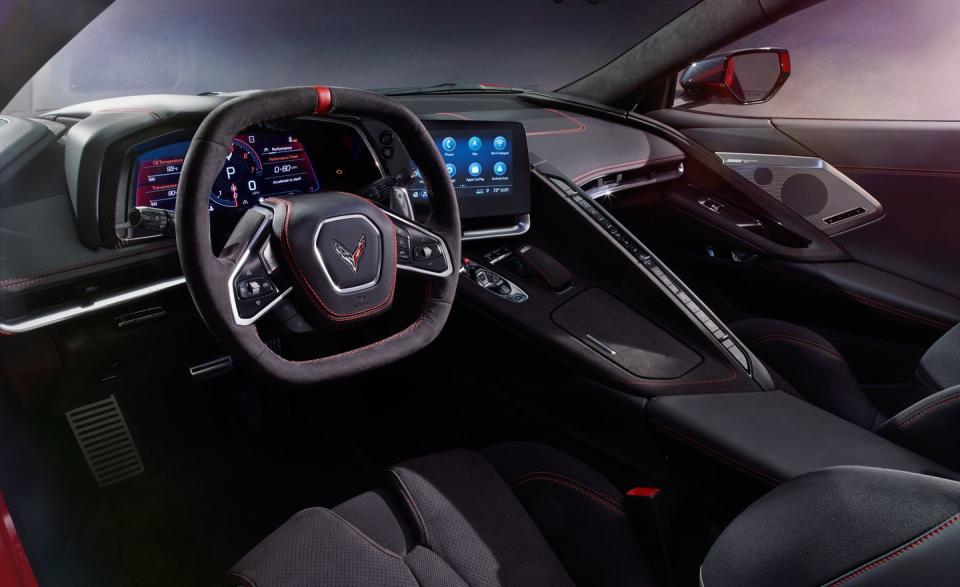The Mid-Engined 2020 Chevy Corvette Is Here

The eighth-generation Chevrolet Corvette is the first one that's mid-engined, and there are other changes that will make it vastly different from its predecessors.
There is no manual transmission—not even as an option—and a 6.2-liter V-8 "LT2" engine will be standard on the base Stingray model.
It goes into production in late 2019 and should be on sale shortly after that.
Anticipation can be the best thing about a new toy. Handling that shiny object, still in its blister pack. Goosebumps ripple across your skin; your pupils dilate. The toy comes out, and the serious business of fun begins. Now that Chevrolet has revealed the mid-engined 2020 Corvette, will the joy of playing with it exceed the 60 or so years of anticipatory excitement? Or will it be buried in the sandbox next week?
Any all-new Corvette is significant. The really big fuss is that this one, the eighth generation (C8), has its engine behind the passengers for the first time in Corvette history. It's mid-engined, like a Ferrari F8 Tributo or a McLaren 720S. While that change is obvious, there are subtler changes that are nearly as heretical.

First, there's no manual transmission. It's not even an option. Historians will note that this isn't a first for the Corvette. A manual transmission didn't appear until 1955; the first Vette, back in 1953, only offered an automatic. For the C8, the automatic isn't a two-speed like that '53 model's, it's an eight-speed dual-clutch made by Tremec. The C8's DCT can be shifted manually, but shifts are done wholly by wire. By removing the mechanical connection, the center tunnel can be completely enclosed to increase structural strength.
Leaf springs, the spring type that suspended horse-drawn carriages and a Corvette feature from the beginning are, finally, a thing of the past. The C8 isn't just the first Corvette without leaves, it's the first to support all four corners on coil springs between control arms. The earliest Corvettes used a pair of leaf springs to support the solid rear axle, the C2 and C3 used a transverse leaf spring in their independent rear suspensions, and the C4 through C7 models used composite transverse leaf springs both fore and aft. (While detractors have long loved to use the term "leaf spring" to denigrate the Corvette, there's no denying the impressive capabilities Chevrolet managed with this design.)
Engine
Although the engine is in an unfamiliar place, the V-8 itself is pretty familiar. Like its front-engined predecessor, its power comes from a 6.2-liter pushrod V-8 with the same bore spacing as the original small-block V-8 from 1955. Dubbed the LT2, this engine's fundamental geometry and most of its internals remain the same as the LT1's. Its bore and stroke dimensions are unchanged, and the 11.5:1 compression ratio carries over. Sticking it in the middle of the car means the engine now breathes from the rear. Exhaust manifolds are stainless steel, and every C8 has a dry-sump lubrication system. Total output with the Performance exhaust is now 495 horsepower with 470 lb-ft of peak torque at 5150 rpm. The rev limiter remains at 6600 rpm.
Chevy claims that cars equipped with the Z51 performance package will go from zero to 60 mph in less than 3.0 seconds. This could make it one of the quickest Corvettes ever made—and that's just the base Stingray.

While there's no option to make the C8 sound like a 1967 Corvette 427 with side pipes, the new car does have an active exhaust system that tunes its note depending on drive mode. But changing exhaust modes has no effect on power.
Structure
The C8's stout center tunnel, like the rest of the structure, is aluminum. While a few special versions of the sixth-gen Corvette and the entire seventh generation used aluminum structures, they still had traditional frames with parallel rails running from fore to aft. The C8 does away with the rails in favor of an advanced backbone structure that hangs the front suspension off a subframe.
A mid-engined Corvette, unlike many of its exotic mid-engine competitors, needs to be affordable, both to purchase and to produce. (Pricing will not be released until later this year, but GM president and global product chief Mark Reuss said at the reveal that the car will start under $60,000—we assume that means $59,995 without destination.) Controlling costs is a Chevrolet hallmark, and the C8 is no different. It uses expensive carbon fiber only where it is the most efficient choice in terms of cost, weight, strength, and stiffness. Only two carbon pieces made the cut—a rear bumper beam and an underbody close-out panel that runs along the bottom of the center tunnel, strengthening the backbone of the car. With the exception of the two carbon pieces, the remainder of the C8’s structure is all aluminum: 40 percent extrusions, 39 percent stampings, 18 percent castings, and 1 percent hydroformed pieces.

The aluminum frame is bonded and screwed together and, without its top, the C8 is 19 percent torsionally stiffer than its predecessor, according to GM’s numbers. It is also heavier: Chevy is quoting a dry weight of 3366 pounds, which means a likely curb weight of around 3600 pounds; our long-term C7 Grand Sport tipped the scales at 3483 pounds, for reference.
Trim Levels
Initially, the C8 will be offered in three distinct flavors. The FE1 is the base configuration. It's built to be a great everyday driver that's accessible to buyers who don't need a hero engineered into their shock absorbers or the ultimate adhesion of summer-only tires. One step up is the FE3, which includes the Z51 Performance package (including an electronic limited-slip differential, larger brake discs, and summer tires) but retains conventional shocks. Above them is the FE4 which builds on the FE3 kit with the magic of magnetorheological adaptive dampers. Think of it as a ladder from easygoing to kind-of-awesome to gentlemen-start-your-engines.
GM hopes that, even in the FE1, the C8 will be a 1.00-g car. The miracle workers here are the new Michelin Pilot Sport All Season 4ZP run-flat tires. Z51s running Pilot Sport 4S summer tires should orbit around 1.03 g and 1.05 g.
Styling
The base C8 is still being called a Stingray, and there are familiar elements on the exterior. The front fenders still come to a peak, there's a center spear across the nose, and the hind end swells out and then tucks in. A mid-engined car has a different profile than a front-engined one, so it's the details of the C8 that communicate design continuity with previous-generation Corvettes.

There's a lot of stuff shoehorned into those wide flanks. Ginormous scoops gulp up air for both engine breathing and the side-mounted radiators, and the C8 is the first production Corvette with dual fuel tanks, riding almost as saddlebags just inboard from the side scoops. The most controversial element of the styling will surely be the tail, which sort of looks like it has about 8 percent too much Camaro in the rump. It's not enough to diminish the car's overall visual impact, but a more elegant tail would be welcome.
A subtler change is that some of the engine-coolant heat exchangers on the C8 are mounted on each side of the nose, giving the car a unique face. All previous Corvettes have had a centered radiator. And without it, the C8 has more room for a large frunk, allowing it to uphold the Corvette tradition of being an everyday usable, two-seat sports car. The rear cargo hold, between the engine and bumper, is large enough to swallow the removable roof panel of the targa models. A folding-top convertible is due in time as well. Combine the frunk and the trunk, and you get a total amount of cargo space of 13 cubic feet, two less than the C7 Corvette's hatch.
Interior
With no engine in front, the C8's passenger cell has shifted forward 16.5 inches. Getting in and out is not difficult. The side sills are modest, the doors generously sized, and the seats aren't so low that it seems like you've entered a dungeon.

Looking like it was ripped off a customized 1977 Dodge Tradesman van with the image of a Nordic goddess emerging from a lake airbrushed on the side, the steering wheel is a weird hexagonal shape. It may turn out that round steering wheels have been the wrong solution all these years, but there's still something disconcerting about this one. The thick down-sloped spokes pack the usual assortment of controls.
Don't look for a conventional shifter. Along the center tunnel, there's a set of buttons Chevy calls the Electronic Transmission Range Selector, ETRS for short. Should you want to shift for yourself, there are two large paddles behind the steering wheel.
Most Corvettes will be driven by their owners as their daily driver, so the cockpit is built to be user-friendly in a way that no mid-engined car has been, save perhaps for the two generations of the Acura NSX. Controls literally envelop the driver, with a long strip of buttons on the center console, and there's an eight-inch touchscreen angled toward him for immediate access. Three different seat options—GT1, GT2, and Competition Sport—are proportioned for nearly the entire range of American body percentiles, from large to extremely large and on to vastly enormous.
Entering its 67th year of production, the new Corvette is an engineering moonshot, a marketing leap of faith, and a statement about what an American sports car can truly be. Car and Driver isn't about collecting toys and preserving them in their original packaging. It's time to rip this thing open and play hard. Very, very hard.
You Might Also Like

